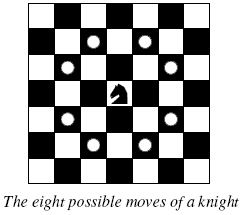A Knight's Journey
| Time Limit: 1000MS | Memory Limit: 65536K | |
| Total Submissions: 26645 | Accepted: 9091 |
Description
 Background
Background The knight is getting bored of seeing the same black and white squares again and again and has decided to make a journey
around the world. Whenever a knight moves, it is two squares in one direction and one square perpendicular to this. The world of a knight is the chessboard he is living on. Our knight lives on a chessboard that has a smaller area than a regular 8 * 8 board, but it is still rectangular. Can you help this adventurous knight to make travel plans?
Problem
Find a path such that the knight visits every square once. The knight can start and end on any square of the board.
Input
The input begins with a positive integer n in the first line. The following lines contain n test cases. Each test case consists of a single line with two positive integers p and q, such that 1 <= p * q <= 26. This represents a p * q chessboard, where p describes how many different square numbers 1, . . . , p exist, q describes how many different square letters exist. These are the first q letters of the Latin alphabet: A, . . .
Output
The output for every scenario begins with a line containing "Scenario #i:", where i is the number of the scenario starting at 1. Then print a single line containing the lexicographically first path that visits all squares of the chessboard with knight moves followed by an empty line. The path should be given on a single line by concatenating the names of the visited squares. Each square name consists of a capital letter followed by a number.
If no such path exist, you should output impossible on a single line.
If no such path exist, you should output impossible on a single line.
Sample Input
3
1 1
2 3
4 3
Sample Output
Scenario #1:
A1
Scenario #2:
impossible
Scenario #3:
A1B3C1A2B4C2A3B1C3A4B2C4
Source
TUD Programming Contest 2005
, Darmstadt, Germany
这个题目的意思是说有一个骑士,他想要走遍所有位置,问是否可以实现,我们在做这
个题目的时侯要用搜索来做,我们可以数走的个数,看是否可以实现使其等于P*Q,这
样就可以了呗,但是最变态的竟然要求按照字典序顺序走,也就是说我们要按照字典序
的顺序走一遍,所以我们要从A1开始走,而且国际象棋是横着是字母,竖着才是数字,
所以我们按照照顾横着的原则,要选择d[x]=-2,-1,1,2,这样的原则来写,其实也就是
按照字典序了,还有一个问题,我们用x来数数,所以x<q,而不是x<p,这个地方害的我
WA了很多遍
#include<iostream>
#include<cstdio>
#include<cstring>
using namespace std;
int p,q;
static int dis[8][2]={-2, -1, -2, 1, -1, -2, -1, 2, 1, -2, 1, 2, 2, -1, 2, 1};//方向
char map[100];
int s[30][30];//标记数组
int dfs(int x,int y,int num)
{
if(num==p*q)
return 1;
int i;
int x1,y1;
for(i=0;i<8;i++)
{
x1=x+dis[i][0];
y1=y+dis[i][1];
if((x1>=0)&&(x1<q)&&(y1>=0)&&(y1<p)&&(s[y1][x1]==0))
{
s[y1][x1]=1;
map[num*2]=x1+'A';
map[num*2+1]=y1+'1';
if(dfs(x1,y1,num+1))
return 1;
s[y1][x1]=0;
}
}
return 0;
}
int main()
{
int t,T;
scanf("%d",&T);
int i;
for(t=1;t<=T;t++)
{
scanf("%d%d",&p,&q);
memset(s,0,sizeof(s));
memset(map,0,sizeof(map));
s[0][0]=1;
map[0]='A';
map[1]='1';
printf("Scenario #%d:\n",t);
if(dfs(0,0,1))
{
for(i=0;i<strlen(map);i++)
{
printf("%c",map[i]);
}
printf("\n\n");
}
else
{
printf("impossible\n\n");
}
}
return 0;
}
























 307
307

 被折叠的 条评论
为什么被折叠?
被折叠的 条评论
为什么被折叠?








